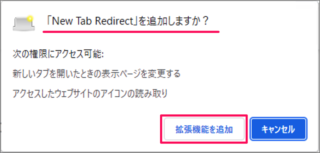

However, this appears to be undocumented and unreliable. Using to redirect the new tab page has historically highlighted the URL.There's an ongoing, unsolved thread on this topic here for the Chrome extension New Tab Redirect.

The ideal solution would keep the webpage be the top frame of the new tab page, and the omnibox would be either cleared or highlighted. However, this does not reliably highlight the omnibox, so users have to manually set focus to the omnibox before typing, which is a poor user experience.
#New tab redirect windows#
Go to Safari > Preferences > Tabs and set Open pages in tabs instead of windows to Automatically. However, it does provide control over links that open in new windows. Safari does not have any extensions (at the time of writing) that can automatically open links in new tabs, so you have no recourse but to rely on your keyboard and mouse/trackpad solely. To activate it, open the Options page in Firefox, select the General tab, and check the box next to Open links in tabs instead of new windows. To manage how the extension works, head over to Add-ons and Themes > Extensions.Īdditionally, Firefox provides a built-in option that allows you to force-load links in tabs instead of new windows.
#New tab redirect install#
Just install it, and every link that you come across should open in a new tab. The Firefox Browser Add-ons store also contains several extensions that can open links in new tabs. Then, turn on the switch next to Allow in incognito. If you want to expand your preferred extension’s support to include Incognito windows in Chrome, open the Extensions menu and go to Manage extensions > Details. After adding it to Chrome, simply pick the extension from the browser’s Extensions menu and turn on the switch to activate it for the site you’re viewing.Īnother extension, dubbed Right Click Opens Link in New Tab, allows you to configure the right mouse button or trackpad gesture to open links in the background or the foreground. The extension Open in new tab, for example, allows you to open links in the background easily. You should be able to locate multiple extensions offering the functionality to force-load links in new browser tabs. Suppose you use Google Chrome, head over to the Chrome Web Store, and search for open links in new tabs. Some browsers also come with the option to open links in new tabs as opposed to new windows. If you don’t like using the keyboard, mouse, or trackpad in unusual ways to open links in new tabs, or if you’re physically disadvantaged, then browser extensions can help.
#New tab redirect how to#
How to Use Extensions to Force-Open Links in New Tabs They should also work with the Mac’s Magic Mouse. However, you can use third-party apps such as MiddleClick or Middle to add support for that. MacBook trackpads don’t have a middle-click gesture. You can configure the middle mouse click by heading over to Settings > Devices > Touchpad. To do that, you must emulate a middle-click by clicking or tapping with three fingers. Trackpads on Windows laptops can also open links in new tabs. Redirect the local new tab page to the webpage.


 0 kommentar(er)
0 kommentar(er)
